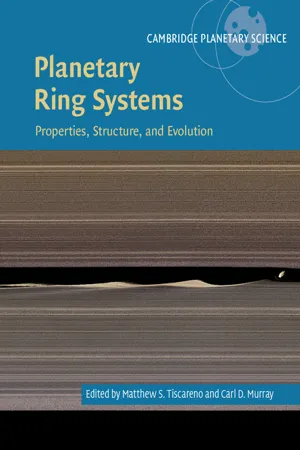
Planetary Ring Systems
Properties, Structure, and Evolution
- English
- PDF
- Available on iOS & Android
About this book
Planetary rings are among the most intriguing structures of our solar system and have fascinated generations of astronomers. Collating emerging knowledge in the field, this volume reviews our current understanding of ring systems with reference to the rings of Saturn, Uranus, Neptune, and more. Written by leading experts, the history of ring research and the basics of ring–particle orbits is followed by a review of the known planetary ring systems. All aspects of ring system science are described in detail, including specific dynamical processes, types of structures, thermal properties and their origins, and investigations using computer simulations and laboratory experiments. The concluding chapters discuss the prospects of future missions to planetary rings, the ways in which ring science informs and is informed by the study of other astrophysical disks, and a perspective on the field's future. Researchers of all levels will benefit from this thorough and engaging presentation.
Frequently asked questions
- Essential is ideal for learners and professionals who enjoy exploring a wide range of subjects. Access the Essential Library with 800,000+ trusted titles and best-sellers across business, personal growth, and the humanities. Includes unlimited reading time and Standard Read Aloud voice.
- Complete: Perfect for advanced learners and researchers needing full, unrestricted access. Unlock 1.4M+ books across hundreds of subjects, including academic and specialized titles. The Complete Plan also includes advanced features like Premium Read Aloud and Research Assistant.
Please note we cannot support devices running on iOS 13 and Android 7 or earlier. Learn more about using the app.
Information
Table of contents
- Cover
- Half-title page
- Series page
- Title page
- Copyright page
- Contents
- List of Contributors
- Acknowledgements
- I Introductory Material
- II Ring Systems by Location
- III Ring Systems by Type and Topic
- IV Concluding Material
- Index